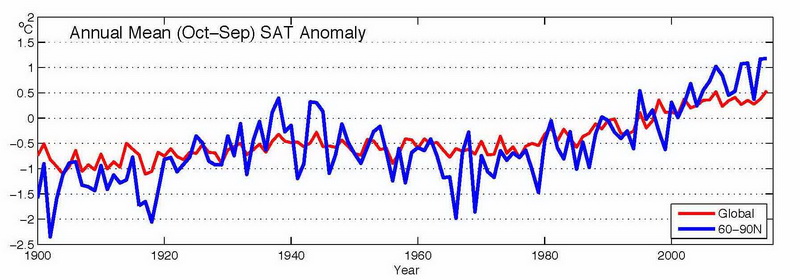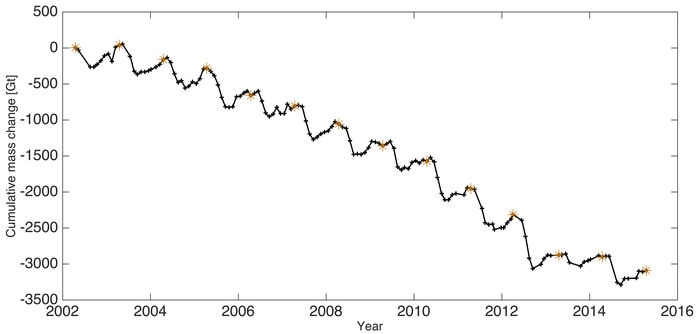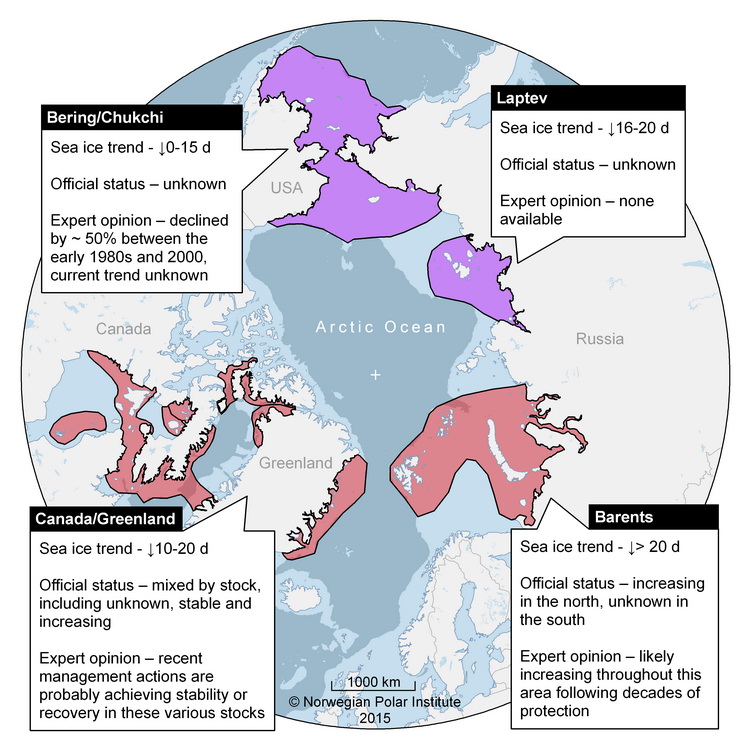AGU 2015: Scientists offer latest update on worsening state of Arctic
Posted on 22 December 2015 by Guest Author
This is a re-post from Roz Pidcock at Carbon Brief
Scientists at this year’s American Geophysical Union conference in San Francisco, the largest coming together of earth and space scientists in the world, have issued their latest health-check for the Arctic.
Compiled by more than 70 authors in 11 countries, the annual Arctic Report Card put together by the US National Oceanographic and Atmospheric Administration (NOAA) is considered the most comprehensive overview of the state of the polar north.
This year’s instalment tells the familiar story of an Arctic in serious decline. Temperatures are rising and ice is retreating, with knock-on effects for Arctic ecosystems and wildlife.
Dr James Overland, an Arctic oceanographer with NOAA and one of the report’s authors, told Carbon Brief:
The importance of the report card is that almost every year we see new surprises in the rapidity of the types of changes that we’re seeing.
Here’s your one-stop-shop for understanding what’s been going on in the Arctic this year.
Vital signs
Arctic temperatures are rising more than twice as fast as the rest of the world, today’s report begins. For the 12-month period between October 2014 and September 2015, temperatures were 1.3°C above the long-term average, the highest since 1900. In all four seasons, temperatures over large parts of the region exceeded 3C above the pre-industrial era.
These latest figures represent a warming of 2.3°C since the 1970s and 2.9°C since the start of the 19th century. And while the surface temperature of the globe as a whole has risen more slowly in the past decade than previous ones, there has been no such slowdown in the Arctic, the report notes. Compare the blue line in the graph below, which shows the average annual temperature since 1900, with the red line, which shows the same but for the whole globe.

Annual average surface temperature for Arctic land stations above 60N (blue) and global (red) for the period 1900-2015, relative to the 1981-2010 average. Overland et al (2015) NOAA Arctic Report Card: Update for 2015.
While you can see ups and downs in Arctic temperature (blue line above) from one year to the next, the long term trend is one of clear warming, today’s report explains:
Although there are year-to-year and regional differences in air temperatures due to natural random variability, the magnitude and Arctic-wide character of the long-term temperature increase is a major indicator of global warming.
These natural fluctuations also mean that scientists see differences from one Arctic region to another in any given season, the report explains.
Greenland in decline
Since satellite records began in the late 1970s, they have shown Arctic ice decreasing in response to rising temperatures – and this year is no different, today’s report explains.
For the first time since the record year of 2012, ice melted over more than 50% of the surface of Greenland. The melt season lasted a record-breaking 30-40 days longer than usual over some, but not all, of the ice sheet. Between April 2014 and April 2015, Greenland lost 186bn tonnes of ice, according to measurements from NASA’s GRACE satellites, which measure changes in Earth’s gravitational field. This is about 20% less than the average per year over the whole satellite record (2002-2015), but continues the long-term downward trend.

Total ice loss from Greenland between 2002-2015, as measured by the GRACE satellite. Orange stars are the cumulative mass loss as measured in April of each year. 1GT is 1 gigatonne or 1 billion tonnes. Tedesco et al. (2015) NOAA Arctic Report Card: Update for 2015.
Sea ice status
Every year, Arctic sea ice reaches its seasonal high in March as winter draws to a close. But the winter peak in 2015 was the smallest since 1979 and occurred about 15 days earlier than usual, the report notes. The seasonal summer low in September was also the 4th lowest on record.
It’s not just the amount of sea ice each year that’s changing, it’s the nature of it, too. Only 3% of ice cover at the winter maximum was more than four years old, while 70% was first-year ice. Go back 30 years and the picture looked very different. In 1985, older sea ice made up a much bigger proportion – about 20% – and ice less than a year old contributed just 35%.
Declining even faster than sea ice is summer snow cover, the report notes. Having never previously dropped below 3m square kilometres in the 43-year long record (1967-2008), snow cover in June dropped below this level in five years out of the last six. As a result, the combined discharge of the 10 biggest rivers in the Arctic in 2015 was 10% greater than long-term average.
Arctic ecosystems
Changes in the sea ice are having profound impacts on species that call the Arctic home. One example today’s report highlights is the iconic walrus. It’s a complicated picture and data is lacking in some places, but scientists project diminishing sea ice will reduce their access to prey and cause the animals to come ashore in huge numbers more frequently – known as “haul outs”.
Habitat loss is likely to be exacerbated by other climate-change related factors, such as ocean acidification, as well as shipping, oil and gas development and contaminants, the report notes.
Sea ice loss and rising temperatures in the Barents Sea are also causing fish species tomigrate northwards towards the poles away from their usual habitats further south, the report notes.

Sea ice trends and the status of walrus populations across the Arctic. The downwards arrows represent a loss of sea ice while the number denotes the number of days less ice coverage per decade. Kovacs et al. (2015) NOAA Arctic Report Card: Update for 2015.
Rising temperatures are reducing the amount of vegetation on land, causing a general “browning” of the Arctic tundra and reversing the “greening” trend of the past three decades. Beyond simply altering the landscape, this loss of vegetation has consequences for the frozen ground that lies beneath, known as permafrost. Prof Howard Epstein from the University of Virginia told a press conference at AGU how vegetation helps to keep temperatures down in summer, reducing the amount of permafrost at risk of thawing. He said:
Increasing the vegetation on the landscape will do a couple of things: it provides insulation to whatever’s below the vegetation…Vegetation tends to trap windblown snow, and that can also provide an insulating effect for winter soils.
Vegetation also changes the reflectivity of the land, known as the albedo. Fewer plants means a less reflective surface, which could lead to faster warming of the overlying air, says Epstein.
COP21 and the 2°C limit
Coming just days after countries signed a historic agreement in Paris to curb greenhouse gas emissions, nowhere demonstrates the need to limit warming more than the Arctic, says Dr Martin Jeffries, Arctic science advisor at the US Office for Naval Research and lead author of today’s report. He tells Carbon Brief:
COP21 calls for a global average of 2°C as a maximum for the rise in global temperature. We already know that the world is not uniformly warming, but in some places such as the Arctic, it’s warming much more quickly.
Models suggest that an average global temperature rise of 2°C would mean the Arctic experiences much higher warming, Overland told today’s press conference:
If the globe goes to 2C warming, we’re looking at 4-5°C warming in the winter for the Arctic by 2040 or 2050. That’s based upon the CO2 that we’ve already put into the atmosphere and will be putting in for the next 20 years.
The Arctic is already in “adaptation mode”, says Overland, because of the impacts humanity’s past emissions have locked us into. Cutting our emissions now to meet the 2°C goal would have a bigger influence in the second half of the century, he explains.
The next generation may see an ice-free summer, but hopefully their descendents will see a return of more sea ice later in the century.
One bit of good news, Overland concludes, is the close association between air temperature and sea ice. If we stabilise global temperature, we can stabilise the Arctic climate as well.































 Arguments
Arguments






























James Overland is the first person (of course excluding AGW deniers and bunkum nonsense repeaters) I've heard saying that arctic sea ice will actually recover later this century if people take action to stabilise climate.
Remarkable piece of optimism, James! Especially among many reports saying that ice free arctic is inevitable within our lifetimes and beyond that... nothing. Eventually: water has lower albedo, more warming, more gloom and doom.
I find this report not only superficial but glaringly incomplete.
It makes no mention of the effects of arctic amplification on the rate of permafrost decay and consequential carbon release.
It makes no mention of the rate of shoreline erosion as a result of ocean warming or resulting exposure of carbon deposits, particularly in yedoma.
It seemingly ignores the prognosis for future rate of Arctic temperature rise caused by the above, particularly as a result of methane releases to the atmosphere.